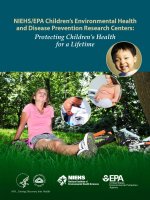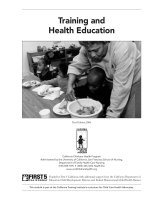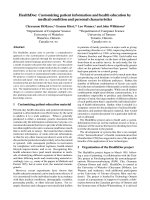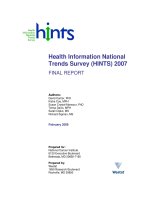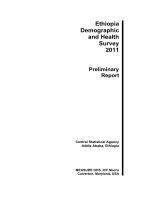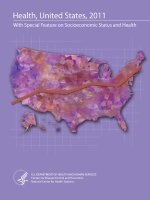Demographic and Health Survey 2011 : Ethiopia pptx
Bạn đang xem bản rút gọn của tài liệu. Xem và tải ngay bản đầy đủ của tài liệu tại đây (2.4 MB, 452 trang )
Ethiopia
2011
Demographic and
Health Survey
Ethiopia 2011 Demographic and Health Survey
Ethiopia
Demographic and
Health Survey
2011
Central Statistical Agency
Addis Ababa, Ethiopia
ICF International
Calverton, Maryland, USA
March 2012
The 2011 Ethiopia Demographic and Health Survey (2011 EDHS) is part of the worldwide
MEASURE DHS project which is funded by the United States Agency for International Development
(USAID). The survey was implemented by the Ethiopian Central Statistical Agency (CSA). The
funding for the EDHS was provided by the HIV/AIDS Prevention and Control Office (HAPCO),
USAID, the United Nations Population Fund (UNFPA), the United Kingdom for International
Development (DFID), the United Nations Children’s Fund (UNICEF) and the Centers for Disease
Control and Prevention (CDC). ICF International provided technical assistance through the
MEASURE DHS project. The opinions expressed herein are those of the authors and do not
necessarily reflect the views of USAID.
Additional information about the 2011 EDHS may be obtained from the Central Statistical Agency,
P.O. Box 1143, Addis Ababa, Ethiopia; Telephone: (251) 111 55 30 11/111 15 78 41,
Fax: (251) 111 55 03 34, E-mail:
Information about the MEASURE DHS project may be obtained from ICF International, 11785
Beltsville Drive, Suite 300, Calverton, MD 20705, USA; Telephone: 301-572-0200,
Fax: 301-572-0999, E-mail: , Internet: .
Suggested citation:
Central Statistical Agency [Ethiopia] and ICF International. 2012. Ethiopia Demographic and Health
Survey 2011. Addis Ababa, Ethiopia and Calverton, Maryland, USA: Central Statistical Agency and
ICF International.
Contents • iii
CONTENTS
TABLES AND FIGURES ix
FOREWORD xv
ACKNOWLEDGMENTS xvii
MILLENNIUM DEVELOPMENT GOAL INDICATORS xix
CHAPTER 1 INTRODUCTION
1.1 History, Geography, and Economy 1
1.2 Population 3
1.3 Population and Health Policies 4
1.4 Objectives of the 2011 EDHS Survey 5
1.5 Organization of the Survey 6
1.6 Sample Design 7
1.7. Questionnaires 7
1.8 Listing, Pretest, Main Training, Fieldwork, and Data Processing 8
1.9 Anthropometry, Anaemia, and HIV Testing 10
1.10 Response Rates 11
CHAPTER 2 HOUSING CHARACTERISTICS AND HOUSEHOLD POPULATION
2.1 Household Environment 13
2.1.1 Drinking Water 13
2.1.2 Household Sanitation Facilities 15
2.1.3 Housing Characteristics 16
2.1.4 Household Possessions 18
2.2 Wealth Index 19
2.3 Population by Age and Sex 20
2.4 Household Composition 21
2.5 Children’s Living Arrangements and Parental Survival 22
2.6 Education of the Household Population 25
2.6.1 School Attendance by Survivorship of Parents 25
2.6.2 Educational Attainment 26
2.6.3 School Attendance Ratios 28
2.7 Child Labour 31
CHAPTER 3 CHARACTERISTICS OF RESPONDENTS
3.1 Characteristics of Survey Respondents 35
3.2 Educational Attainment by Background Characteristics 37
3.3 Literacy 39
3.4 Exposure to Mass Media 41
3.5 Employment 44
3.6 Occupation 48
3.7 Type Of Women’s Employment 50
3.8 Health Iss
ues 51
3.8.1 Use of Tobacco 51
3.8.2 Alcohol Consumption 52
3.8.3 Chewing Chat 53
3.8.4 Knowledge and Attitudes concerning Tuberculosis 55
iv • Contents
CHAPTER 4 MARRIAGE AND SEXUAL ACTIVITY
4.1 Current Marital Status 59
4.2 Polygyny 60
4.3 Age at First Marriage 62
4.4 Age at First Sexual Intercourse 64
4.5 Recent Sexual Activity 66
CHAPTER 5 FERTILITY LEVELS, TRENDS, AND DIFFERENTIALS
5.1 Current Fertility 69
5.2 Fertility Differentials by Background Characteristics 71
5.3 Fertility Trends 72
5.4 Children Ever Born and Living 73
5.5 Birth Intervals 74
5.6 Postpartum Amenorrhoea, Abstinence, and Insusceptibility 76
5.7 Menopause 77
5.8 Age at First Birth 78
5.9 Teenage Pregnancy and Motherhood 79
CHAPTER 6 FERTILITY PREFERENCES
6.1 Desire for More Children 81
6.2 Desire to Limit Childbearing by Background Characteristics 83
6.3 Ideal Number of Children 86
6.4 Mean Ideal Number of Children by Women’s Background Characteristics 88
6.5 Fertility Planning Status 89
6.6 Wanted Fertility Rates 90
CHAPTER 7 FAMILY PLANNING
7.1 Knowledge of Contraceptive Methods 93
7.2 Current Use of Contraceptive Methods 95
7.2.1 Current Use of Contraceptive Methods By Age 95
7.2.2 Trends in Contraceptive Use 97
7.3 Current Use of Contraception by Background Characteristics 97
7.4 Source of Modern Contraceptive Methods 99
7.5 Informed Choice 99
7.6 Knowledge of the Fertile Period 100
7.7 Need and Demand for Family Planning 101
7.8 Future Use of Contraception 102
7.9 Exposure to Family Planning Messages 102
7.10 Exposure to Specific Type of Family Planning Messages 105
7.11 Contact of Nonusers with F
amily Planning Providers 106
7.12 Contraceptive Discontinuation Rate 108
CHAPTER 8 INFANT AND CHILD MORTALITY
8.1 Data Quality 110
8.2 Levels and Trends in Infant and Child Mortality 111
8.2.1 Early Childhood Mortality Rates 111
8.2.2 Trends in Early Childhood Mortality 111
8.3 Early Childhood Mortality Rates by Socioeconomic Characteristics 112
8.4 Demographic Differentials in Infant and Child Mortality 114
8.5 Perinatal Mortality 115
8.6 High-Risk Fertility Behaviour 117
Contents • v
CHAPTER 9 MATERNAL HEALTH
9.1 Antenatal Care 119
9.1.1 Coverage of Antenatal Care 120
9.1.2 Number of ANC Visits, Timing of First Visit, and Source Where ANC
Was Received 121
9.1.3 Components of Antenatal Care 122
9.1.4 Informed of signs of pregnancy complications during pregnancy 124
9.2 Tetanus Toxoid Injections 124
9.3 Place of Delivery 126
9.4 Assistance during Delivery 127
9.5 Reasons for Not Delivering in a Health Facility 128
9.6 Postnatal Care 129
9.6 Problems in Accessing Health Care 131
CHAPTER 10 CHILD HEALTH
10.1 Child’s Size at Birth 135
10.2 Vaccination Coverage 138
10.2.1 Vaccinations Coverage by Background Characteristics 140
10.3 Trends in Vaccination Coverage 141
10.4 Acute Respiratory Infection 142
10.5 Fever 143
10.6 Diarrhoeal Disease 146
10.6.1 Prevalence of Diarrhoea 146
10.6.2 Treatment of Diarrhoea 148
10.6.3 Feeding Practices during Diarrhoea 150
10.7 Knowledge of ORS Packets 152
10.8 Stool Disposal 153
CHAPTER 11 NUTRITION OF CHILDREN AND ADULTS
11.1 Nutritional Status of Children 156
11.1.1 Measurement of Nutritional Status among Young Children 156
11.1.2 Data Collection 157
11.1.3 Measures of Children’s Nutritional Status 158
11.1.4 Trends
in Children’s Nutritional Status 161
11.2 Breastfeeding and Complementary Feeding 162
11.2.1 Initiation of Breastfeeding 162
11.2.2 Breastfeeding Status by Age 164
11.2.3 Duration of Breastfeeding 168
11.2.4 Types of Complementary Foods 169
11.2.5 Infant and Young Child Feeding (IYCF) Practices 171
11.3 Prevalence of Anaemia in Children 173
11.4 Micronutrient Intake among Children 175
11.5 Iodisation of Household Salt 179
11.6 Nutritional Status of Women and Men 180
11.7 Prevalence of Anaemia in Women 184
11.8 Prevalence of Anaemia in Men 186
11.9 Micronutrient Intake among Mothers 186
vi • Contents
CHAPTER 12 HIV/AIDS-RELATED KNOWLEDGE, ATTITUDES, AND BEHAVIOUR
12.1 HIV/AIDS Knowledge, Transmission, and Prevention Methods 190
12.1.1 Awareness of HIV/AIDS 190
12.1.2 Rejection of Misconceptions about HIV/AIDS 192
12.2 Knowledge of Prevention of Mother-to-Child Transmission of HIV 195
12.3 Attitudes towards People Living with HIV/AIDS 196
12.4 Attitudes towards Refusing to Have Sex and Negotiating Safer Sex 198
12.5 Adult Support for Education about Condoms for Children Age 12 14 200
12.6 Higher-Risk Sex 201
12.6.1 Multiple Partners and Condom Use 201
12.6.2 Transactional Sex 205
12.7 Coverage of HIV Testing 206
12.7.1 General HIV Testing 206
12.7.2 HIV Counseling and Testing During Pregnancy 208
12.8 Male Circumcision 210
12.9 Self-Reporting of Sexually Transmitted Infections 211
12.10 Prevalence of Medical Injections 213
12.11 HIV/AIDS Knowledge and Sexual Behaviour among Youth 215
12.11.1 HIV/AIDS-Related Knowledge among Young Adults 215
12.11.2 Age at First Sexual Intercourse 216
12.11.3 Abstinence and Premarital Sex 219
12.11.4 Multiple Partnerships among Young Adults 221
12.11.5 Age-mixing in Sexual Relationships 222
12.11.6 Recent HIV Testing Among Youth 223
12.12 Use of Alcohol or Chat during Sexual Intercourse 224
12.13 Sharing of HIV Test Results Among Couples 226
12.14 Participation in Community Conversation Programme 227
CHAPTER 13 HIV PREVALENCE
13.1 Coverage Rates for HIV Testing 231
13.2 HIV Prevalence 234
13.2.1 HIV Prevalence by Age and Sex 234
13.2.2 HIV Prevalence by Socioeconomic Characteristics 235
13.2.3 HIV Prevalence by Demographic Characteristics 236
13.2.4 HIV Prevalence by Sexual Risk Behaviour 237
13.3 HIV Prevalence among Youth 238
13.3.1 HIV Prevalence by Sexual Behaviour among Youth 239
13.4 HIV Prevalence by Other Characteristics 240
13.4.1 HIV Prevalence and STIs 240
13.4.2 Prior HIV Testing and Current HIV Status 241
13.4.3 HIV Prevalence by Male Circumcision 241
13.5 HIV Prevalence among Cohabiting Couples 243
Contents • vii
CHAPTER 14 WOMEN’S EMPOWERMENT AND DEMOGRAPHIC AND HEALTH OUTCOMES
14.1 Employment and Form of Earnings 246
14.2 Control Over and Relative Magnitude of Women’s and Husband’s Earnings 247
14.2.1 Control Over Wife’s Earnings 247
14.2.2 Control Over Husband’s Earnings 249
14.3 Control Over Married Women’s Earnings and Relative Size of
Husband’s and Wife’s Earnings 250
14.4 Ownership of Assets 252
14.5 Women’s Participation in Decision-Making 253
14.6 Attitude towards Wife Beating 256
14.7 Women’s Empowerment Indices 259
14.8 Current Use of Contraception by Women’s Status 260
14.9 Ideal Family Size and Unmet Need by Women’s Status 261
14.10 Women’s Status and Reproductive Health Care 262
14.11 Differentials in Infant and Child Mortality by Women’s Status 263
14.12 Men’s Participation in Household Chores 264
14.13 Law Against Domestic Violence 265
CHAPTER 15 ADULT AND MATERNAL MORTALITY
15.1 Assessment of Data Quality 267
15.2 Estimates of Adult Mortality 268
15.3 Estimates of Maternal Mortality 270
REFERENCES 273
APPENDIX A SAMPLE IMPLEMENTATION 275
APPENDIX B ESTIMATES OF SAMPLING ERRORS 287
APPENDIX C DATA QUALITY TABLES 307
APPENDIX D PERSONS INVOLVED IN THE 2011 ETHIOPIA DEMOGRAPHIC
AND HEALTH SURVEY 317
APPENDIX E QUESTIONNAIRES 327
Tables and Figures • ix
TABLES AND FIGURES
CHAPTER 1 INTRODUCTION
Table 1.1 Basic demographic indicators 3
Table 1.2 Results of the household and individual interviews 12
CHAPTER 2 HOUSING CHARACTERISTICS AND HOUSEHOLD POPULATION
Table 2.1 Household drinking water 14
Table 2.2 Household sanitation facilities 16
Table 2.3 Household characteristics 17
Table 2.4 Household possessions 19
Table 2.5 Wealth quintiles 20
Table 2.6 Household population by age, sex, and residence 20
Table 2.7 Household composition 22
Table 2.8 Children's living arrangements and orphanhood 24
Table 2.9 School attendance by survivorship of parents 26
Table 2.10.1 Educational attainment of the female household population 27
Table 2.10.2 Educational attainment of the male household population 28
Table 2.11 School attendance ratios 30
Table 2.12 Child labour 33
Figure 2.1 Population pyramid 21
Figure 2.2 Age-specific attendance rates of the de facto population 5 to 24 years 31
CHAPTER 3 CHARACTERISTICS OF RESPONDENTS
Table 3.1 Background characteristics of respondents 36
Table 3.2.1 Educational attainment: Women 38
Table 3.2.2 Educational attainment: Men 39
Table 3.3.1 Literacy: Women 40
Table 3.3.2 Literacy: Men 41
Table 3.4.1 Exposure to mass media: Women 42
Table 3.4.2 Exposure to mass media: Men 43
Table 3.5.1 Employment status: Women 45
Table 3.5.2 Employment status: Men 47
Table 3.6.1 Occupation: Women 48
Table 3.6.2 Occupation: Men 49
Table 3.7 Type of employment: Women 50
Table 3.8 Use of tobacco: Men 51
Table 3.9.1 Alcohol consumption: Women 52
Table 3.9.2 Alcohol consumption: Men 53
Table 3.10.1 Chewing chat: Women 54
Table 3.10.2 Chewing chat: Men 55
Table 3.11.1 Knowledge and attitude concerning tuberculosis: Women 56
Table 3.11.2 Knowledge and attitude concerning tuberculosi
s: Men 57
Figure 3.1 Women’s employment status in the past 12 months 46
x • Tables and Figures
CHAPTER 4 MARRIAGE AND SEXUAL ACTIVITY
Table 4.1 Current marital status 60
Table 4.2.1 Number of women's co-wives 61
Table 4.2.2 Number of men's wives 62
Table 4.3 Age at first marriage 63
Table 4.4 Median age at first marriage by background characteristics 64
Table 4.5 Age at first sexual intercourse 65
Table 4.6 Median age at first sexual intercourse by background characteristics 66
Table 4.7.1 Recent sexual activity: Women 67
Table 4.7.2 Recent sexual activity: Men 68
CHAPTER 5 FERTILITY LEVELS, TRENDS, AND DIFFERENTIALS
Table 5.1 Current fertility 70
Table 5.2 Fertility by background characteristics 71
Table 5.3.1 Trends in age-specific fertility rates 72
Table 5.3.2 Trends in age-specific and total fertility rates 73
Table 5.4 Children ever born and living 74
Table 5.5 Birth intervals 75
Table 5.6 Postpartum amenorrhoea, abstinence, and insusceptibility 76
Table 5.7 Median duration of amenorrhoea, postpartum abstinence, and
postpartum insusceptibility 77
Table 5.8 Menopause 78
Table 5.9 Age at first birth 78
Table 5.10 Median age at first birth 79
Table 5.11 Teenage pregnancy and motherhood 80
Figure 5.1 Age-specific fertility rates by urban-rural residence 71
CHAPTER 6 FERTILITY PREFERENCES
Table 6.1 Fertility preferences by number of living children 82
Table 6.2.1 Desire to limit childbearing: Women 84
Table 6.2.2 Desire to limit childbearing: Men 85
Table 6.3 Ideal number of children 87
Table 6.4 Mean ideal number of children by background characteristics 89
Table 6.5 Fertility planning status 90
Table 6.6 Wanted fertility rates 91
Figure 6.1 Desire for more children among currently married women 83
Figure 6.2 Trends in mean ideal family size among women and men 86
CHAPTER 7 FAMILY PLANNING
Table 7.1 Knowledge of contraceptive methods 94
Table 7.2 Current use of contrac
eption by age 96
Table 7.3 Current use of contraception by background characteristics 98
Table 7.4 Source of modern contraception methods 99
Table 7.5 Informed choice 100
Table 7.6 Knowledge of fertile period 100
Table 7.7 Need and demand for family planning among currently married women 101
Table 7.8 Future use of contraception 102
Table 7.9 Exposure to family planning messages 104
Tables and Figures • xi
Table 7.10 Exposure to specific family planning messages 106
Table 7.11 Contact of nonusers with family planning providers 107
Table 7.12 Contraceptive discontinuation rates 108
Figure 7.1 Trends in current use of contraceptives among currently married women 97
CHAPTER 8 INFANT AND CHILD MORTALITY
Table 8.1 Early childhood mortality rates 111
Table 8.2 Early childhood mortality rates by socioeconomic characteristics 113
Table 8.3 Early childhood mortality rates, by demographic characteristics 114
Table 8.4 Perinatal mortality 116
Table 8.5 High-risk fertility behaviour 117
Figure 8.1 Trends in early childhood mortality 112
Figure 8.2 Under-five mortality by socioeconomic characteristics 114
Figure 8.3 Infant and under-five mortality rate by selected demographic characteristics 115
CHAPTER 9 MATERNAL HEALTH
Table 9.1 Antenatal care 120
Table 9.2 Number of antenatal care visits and timing of first visit 122
Table 9.3 Components of antenatal care 123
Table 9.4 Informed of signs of pregnancy complications 124
Table 9.5 Tetanus toxoid injections 125
Table 9.6 Place of delivery 126
Table 9.7 Assistance during delivery 128
Table 9.8 Reasons for not delivering in a health facility 129
Table 9.9 Timing of first postnatal checkup for the mother 130
Table 9.10 Type of provider of first postnatal checkup for the mother 131
Table 9.11 Problems in accessing health care 133
CHAPTER 10 CHILD HEALTH
Table 10.1 Child's weight and size at birth 137
Table 10.2 Vaccinations by source of information
139
Table 10.3
Vaccinations by background characteristics 140
Table 10.4 Vaccinations in first year of life 141
Table 10.5 Prevalence and treatment of symptoms of ARI 143
Table 10.6 Prevalence and treatment of fever 145
Table 10.7 Prevalence of diarrhoea 147
Table 10.8 Diarrhoea treatment 149
Table 10.9 Feeding practices during diarrhoea 151
Table 10.10 Knowledge of ORS packets 152
Table 10.11 Disposal of children's stools 154
Figure 10.1 Percentage of children age 12-23 months with specific vaccinations 139
Figure 10.2 Trends in vaccination coverage during the first year of life among children
12-23 months 142
CHAPTER 11 NUTRITION OF CHILDREN AND ADULTS
Table 11.1 Nutritional status of children 159
Table 11.2 Initial breastfeeding 163
xii • Tables and Figures
Table 11.3 Breastfeeding status by age 166
Table 11.4 Median duration of breastfeeding 168
Table 11.5 Foods and liquids consumed by children in the day or night preceding
the interview 170
Table 11.6 Infant and young child feeding (IYCF) practices 172
Table 11.7 Prevalence of anaemia in children 174
Table 11.8 Micronutrient intake among children 178
Table 11.9 Presence of iodised salt in household 179
Table 11.10.1 Nutritional status of women 182
Table 11.10.2 Nutritional status of men 183
Table 11.11.1 Prevalence of anaemia in women 185
Table 11.11.2 Prevalence of anaemia in men 186
Table 11.12 Micronutrient intake among mothers 188
Figure 11.1 Nutritional status of children by age 161
Figure 11.2 Trends in nutritional status of children under age 5 162
Figure 11.3 Infant feeding practices by age 165
Figure 11.4 IYCF indicators of breastfeeding status 167
Figure 11.5 Trends in anaemia status among children 6-59 months 175
CHAPTER 12 HIV/AIDS-RELATED KNOWLEDGE, ATTITUDES, AND BEHAVIOUR
Table 12.1 Knowledge of AIDS 190
Table 12.2 Knowledge of HIV prevention methods 191
Table 12.3.1 Comprehensive knowledge about AIDS: Women 193
Table 12.3.2 Comprehensive knowledge about AIDS: Men 194
Table 12.4 Knowledge of prevention of mother-to-child transmission of HIV 196
Table 12.5.1 Accepting attitudes toward those living with HIV/AIDS: Women 197
Table 12.5.2 Accepting attitudes toward those living with HIV/AIDS: Men 198
Table 12.6 Attitudes toward negotiating safer sexual relations with husband
199
Table 12.7
Adult support of education about condom use to prevent AIDS 200
Table 12.8.1 Multiple sexual partners: Women 202
Table 12.8.2 Multiple sexual partners: Men 203
Table 12.9 Point prevalence and cumulative prevalence of concurrent sexual partners 204
Table 12.10 Payment for sexual intercourse 205
Table 12.11.1 Coverage of prior HIV testing: Women 207
Table 12.11.2 Coverage of prior HIV testing: Men 208
Table 12.12 Pregnant women counselled and tested for HIV 209
Table 12.13.1 Male circumcision 210
Table 12.13.2 Circumstances surrounding male circumcision 211
Table 12.14 Self-reported prevalence of sexually-transmitted infections (STIs) and
STI symptoms 212
Table 12.15 Prevalence of medical injections 214
Table 12.16 Comprehensive knowledge about AIDS and knowledge of a source of condoms
among young people 216
Table 12.17 Age at first sexual intercourse among young people 218
Table 12.18 Premarital sexual intercourse and condom use during premarital sexual intercourse
among youth 220
Table 12.19.1 Multiple sexual partners in the past 12 months among young people: Women 221
Table 12.19.2 Multiple sexual partners in the past 12 months among young people: Men 222
Table 12.20 Age-mixing in sexual relationships among women and men age 15-19 223
Table 12.21 Recent HIV testing among youth 224
Table 12.22.1 Use of alcohol and/or chat at last sexual intercourse: Women 225
Tables and Figures • xiii
Table 12.22.2 Use of alcohol and/or chat at last sexual intercourse: Men 226
Table 12.23 Sharing of HIV test results among couples 227
Table 12.24.1 Exposure to Community Conversation programme: Women 228
Table 12.24.2 Exposure to Community Conversation programme: Men 229
Figure 12.1 Women and men seeking treatment for STIs 213
Figure 12.2 Trends in age at first sexual intercourse 219
CHAPTER 13 HIV PREVALENCE
Table 13.1 Coverage of HIV testing by residence and region 232
Table 13.2 Coverage of HIV testing by selected background characteristics 233
Table 13.3 HIV prevalence by age 234
Table 13.4 HIV prevalence by socioeconomic characteristics 235
Table 13.5 HIV prevalence by demographic characteristics 236
Table 13.6 HIV prevalence by sexual behaviour 237
Table 13.7 HIV prevalence among young people by background characteristics 239
Table 13.8 HIV prevalence among young people by sexual behaviour 240
Table 13.9 HIV prevalence by other characteristics 241
Table 13.10 Prior HIV testing by current HIV status 241
Table 13.11 HIV prevalence by male circumcision 242
Table 13.12 HIV prevalence among couples 244
Figure 13.1 HIV prevalence for women and men age 15-49 by age groups 234
CHAPTER 14 WOMEN’S EMPOWERMENT AND DEMOGRAPHIC AND HEALTH OUTCOMES
Table 14.1 Employment and cash earnings of currently married women and men 246
Table 14.2.1 Control over women's cash earnings and relative magnitude of women's cash
earnings: Women 248
Table 14.2.2 Control over men's cash earnings 250
Table 14.3 Women's control over their own earnings and over those of their husbands 251
Table 14.4.1 Ownership of assets: Women 252
Table 14.4.2 Ownership of assets: Men 253
Table 14.5 Participation in decision-making 254
Table 14.6 Women's participation in decision-making by background characteristics 254
Table 14.7.1 Attitude towards wife beating: Women
257
Table 14.7.2 Attitude towards wife beating: Men 258
Table 14.8 Indicators of women's empowerment 260
Table 14.9 Current use of contraception by women's empowerment 261
Table 14.10 Women's empowerment and ideal number of children, and unmet need for family
planning 262
Table 14.11 Reproductive health care by women's empowerment 263
Table 14.12 Early childhood mortality rates by women's status 263
Table 14.13 Men's participation in household chores 264
Table 14.14 Knowledge of law against domestic violence 265
Figure 14.1 Number of decisions in which currently married women participate 255
CHAPTER 15 ADULT AND MATERNAL MORTALITY
Table15.1 Adult mortality rates 269
Table 15.2 Adult mortality probabilities 269
xiv • Tables and Figures
Table 15.3 Maternal mortality 270
Figure 15.1 Maternal mortality ratio (MMR) with confidence intervals for the seven years
preceding the 200, 2005, and 2011 Ethiopia DHS 271
APPENDIX A SAMPLE IMPLEMENTATION
Table A.1 Enumeration areas and average EA size in the sampling frame 276
Table A.2 Distribution of households in the sampling frame 276
Table A.3 Sample allocation of clusters and households 277
Table A.4 Sample allocation of completed interviews with women and men 278
Table A.5 Sample implementation 280
Table A.6 Sample implementation: Men 281
Table A.7 Coverage of HIV testing by social and demographic characteristics: Women 282
Table A.8 Coverage of HIV testing by social and demographic characteristics: Men 283
Table A.9 Coverage of HIV testing among interviewed women by sexual behavior
characteristics: Women 284
Table A.10 Coverage of HIV testing among interviewed men by sexual behavior characteristics:
Men 285
APPENDIX B ESTIMATES OF SAMPLING ERRORS
Table B.1 List of selected variables for sampling errors, Ethiopia 2011 290
Table B.2 Sampling errors for national sample, Ethiopia 2011 291
Table B.3 Sampling errors for urban sample, Ethiopia 2011 292
Table B.4 Sampling errors for rural sample, Ethiopia 2011 293
Table B.5 Sampling errors for Tigray region, Ethiopia 2011 294
Table B.6 Sampling errors for Affar region, Ethiopia 2011 295
Table B.7 Sampling errors for Amhara region, Ethiopia 2011 296
Table B.8 Sampling errors for Oromiya region, Ethiopia 2011 297
Table B.9 Sampling errors for Somali region, Ethiopia 2011 298
Table B.10 Sampling errors for Benishangul-Gumuz region, Ethiopia 2011 299
Table B.11 Sampling errors for SNNP region, Ethiopia 2011 300
Table B.12 Sampling errors for Gambela region, Ethiopia 2011 301
Table B.13 Sampling errors for Harari region, Ethiopia 2011 302
Table B.14 Sampling errors for Addis Ababa region, Ethiopia 2011
303
Table B.15
Sampling errors for Dire Dawa region, Ethiopia 2011 304
Table B.16 Sampling errors for adult and maternal mortality rates, Ethiopia 2011 305
APPENDIX C DATA QUALITY TABLES
Table C.1 Household age distribution 307
Table C.2.1 Age distribution of eligible and interviewed women 308
Table C.2.2 Age distribution of eligible and interviewed men 309
Table C.3 Completeness of reporting 310
Table C.4 Births by calendar years 311
Table C.5 Reporting of age at death in days 312
Table C.6 Reporting of age at death in months 313
Table C.7 Nutritional status of children based on NCHS/CDC/WHO International
Reference Population 314
Table C.8 Completeness of Information on Siblings 315
Table C.9 Sibship size and sex ratio of siblings 316
xv • Forward
FOREWORD
The 2011 Ethiopia Demographic and Health Survey (EDHS) was conducted by the Central
Statistical Agency (CSA) under the auspices of the Ministry of Health. The Ethiopian Health and
Nutrition Research Institute (EHNRI) was responsible for the testing of HIV from the dried blood
samples (DBS). This is the third Demographic and Health Survey (DHS) conducted in Ethiopia, under
the worldwide MEASURE DHS project, a USAID-funded project providing support and technical
assistance in the implementation of population and health surveys in countries worldwide. The three
EDHS surveys have been conducted at five-year intervals since 2000, and the 2011 EDHS is the
second survey presenting results on HIV and anemia prevalence. The preliminary report containing
results of selected variables was released in October 2011, and this final report presents the details of
the findings of the survey including results released earlier.
The primary objectives of the 2011 EDHS are to provide up-to-date information for planning,
policy formulation, monitoring, and evaluation of population and health programmes in the country.
The survey was intentionally planned to be fielded at the beginning of the last term of the MDG
reporting period to provide data for the assessment of the Millennium Development Goals (MDGs).
The 2011 EDHS, in conjunction with statistical information obtained from the Welfare Monitoring
Survey (WMS) and the Household Income, Consumption and Expenditure Survey (HICES), provides
critical information for monitoring and evaluating the Growth and Transformation Plan (GTP) as well
as various sector development policies and programmes.
The survey interviewed a nationally representative population in about 18,500 households,
and all women age 15-49 and all men age 15-59 in these households. In this report key indicators
relating to family planning, fertility levels and determinants, fertility preferences, infant, child, adult
and maternal mortality, maternal and child health, nutrition, women’s empowerment, and knowledge
of HIV/AIDS are provided for the nine regional states and two city administrations. In addition, this
report also provides data by urban and rural residence at the country level.
Major stakeholders from various government, non-government, and UN organizations have
been involved and have contributed in the technical, managerial, and operational aspects of the
survey. The CSA acknowledges a number of organizations and individuals who contributed in
various ways to the successful completion of the 2011 EDHS. The Agency is grateful for the
commitment of the Government of Ethiopia and the generous funding support primarily by the
HIV/AIDS Prevention and Control Office (HAPCO), the United States Agency for International
Development (USAID), the United Nations Population Fund (UNFPA), the United Kingdom
Department for International Development (DFID), the United Nations Children’s Fund (UNICEF)
and the Centers for Disease Control and Prevention (CDC). ICF International provided technical
assistance as well as funding to the project through the MEASURE DHS project.
xvi • Forward
The Agency extends a special thanks to the Ministry of Health for the overall co-ordination
and undertaking of the voluntary counseling and testing (VCT) activities and to all members of
institutions represented in the 2011 EDHS Steering and Technical Advisory Committees—MoFED,
EHNRI, USAID, CDC, UNICEF, DFID, WHO, UNAIDS, UNFPA, CORHA—for their valuable
contribution to the successful completion of the survey. Special thanks also goes to the Ethiopia
Health and Nutrition Research Institute (EHNRI), which handled the complicated task of testing the
dry blood samples collected in the field for determining the HIV status of the surveyed population.
The Agency also wishes to acknowledge the tireless efforts of the CSA staff that made this
survey a success. Finally, special thanks go to the field staff and also to the survey respondents, who
were critical to the successful completion of this survey.
Samia Zekaria
Director General
Central Statistical Agency
Acknowledgements • xvii
ACKNOWLEDGEMENTS
The following persons contributed to the preparation of this report:
Mr. Gebeyehu Abelti, Central Statistical Agency
Mr. Jelaludin Ahmed, CDC
Ms. Eleni Seyuom, WHO
Ms. Genet Mengistu, MoFED
Mr. Terefe Bogale, MoFED
Ms. Wegen Tamene, EHNRI
Mr. Desta Kassa, EHNRI
Dr. Belete Tegbaru, EHNRI
Ms. Martha Kibur, UNICEF
Ms. Roman G/Yes, MOH
Ms. Alemitu Seyoum, MOH
Mr. Fantahun Walle, Central Statistical Agency
Mr. Wondwessen Demise, Central Statistical Agency
Mr. Girum Haile, Central Statistical Agency
Mr. Akalework Bezu, Central Statistical Agency
Mr. Assefa Negera, Central Statistical Agency
Mr. Million Taye, Central Statistical Agency
Mr. Ashenafi Seyoum, Central Statistical Agency
Mr. Seyoum Tadesse, Central Statistical Agency
Mr. Hailemariam Teklu, Central Statistical Agency
Mr. Kassahun Mengistu, Central Statistical Agency
Ms. Alemeshet Ayele, Central Statistical Agency
Ms. Alemtsehay Beru, ICF International
Ms. Zhuzhi Moore, ICF International
Dr. Fred Arnold, ICF International
Dr. Pav Govindasamy, ICF International
Ms. Joy Fishel, ICF International
Ms. Anjushree Pradhan, ICF International
Ms. Velma Lopez, ICF International
Millennium Development Goal Indicators • xix
Millennium Development Goal Indicators, Ethiopia 2011
Value
Total Female Male
Goal Indicato
r
1. Eradicate extreme poverty and hunge
r
1.8 Prevalence of underweight children under five years of age
1
26.8% 30.5% 28.7%
2. Achieve unive
r
sal primary education
2.1 Net attendance ratio in primary education
2
65.0% 64.5% 64.5%
2.3 Literacy rate of 15-24 year olds
3
56.9% 75.0% 66.0%
3. Promote gender equality and empower women
3.1a Ratio of girls to boys in primary education
4
1.0
3.1b Ratio of girls to boys in secondary education
4
1.0
3.1c Ratio of girls to boys in tertiary education
4
1.0
4. Reduce child mortalit
y
4.1 Unde
r
-five mortality rate (per 1000 live births)
5
98 per 1,000 122 per 1,000 88 per 1,000
4.2 Infant mortality rate (per 1000 live births)
5
63 per 1,000 84 per 1,000 59 per 1,000
4.3 Proportion of 1 yea
r
-old children immunized against measles 55.7% 55.7% 55.7%
5. Improve maternal health
5.1 Maternal mortality ratio
6
676 deaths per 100,000
5.2 Proportion of births attended by skilled health personnel
7
10.0% na na
5.3 Contraceptive prevalence rate
8
28.6% na na
5.4 Adolescent birth rate
9
79 per 1,000 na na
5.5 a) Antenatal care coverage: at least one ANC visit 42.6% na na
b) Antenatal care coverage: at least four ANC visits 19.1% na na
5.6 Unmet need for family planning 25.3% na na
6. Combat HIV/AIDS, malaria and other diseases
6.1 HIV prevalence among population aged 15-24 0.5% 0.1% 0.3%
6.2 Condom use at last high-risk sex: youth 15-24 years
10
61.6% 47.2% 54.4%
6.3 Percentage of population 15-24 years with comprehensive knowledge About AIDS
1
1
23.9% 34.2% 30.5%
6.4 Ratio of school attendance of orphans to school attendance of non-orphans aged 10-14 years 1.01 0.81 0.90
Urban Rural Total
7. Ensure environmental sustainabilit
y
7.8 Proportion of population using an improved drinking water source
1
2
92.8% 41.6% 50.8%
7.9 Proportion of population using an improved sanitation facilit
y
1
3
18.2% 6.8% 8.8%
na = Not applicable
1
Proportion of children age 0-59 months who are below -2 standard deviations (SD) from the median of the WHO Child Growth Standards in weight-for-age.
2
The rate is based on reported attendance, not enrollment, in primary education among primary school age children (7-14 year-olds). The rate also includes children
of primary school age enrolled in secondary education. This is a proxy for MDG indicator 2.1, Net enrollment ratio.
3
Refers to respondents who attended secondary school or higher or who could read a whole sentence or part of a sentence
4
Based on reported net attendance, not gross enrollment
5
Expressed in terms of deaths per 1,000 live births. Mortality by sex refers to a 10-year reference period preceding the survey. Mortality rates for males and females
combined refer to the 5-year period preceding the survey. The difference in the reference periods explains the apparent inconsistency between the sex-specific and
total mortality rates.
6
Expressed in terms of maternal deaths per 100,000 live births in the 7 -year period preceding the survey
7
Among births in the five years preceding the survey
8
Percentage of currently married women age 15-49 using any method of contraception
9
Equivalent to the age-specific fertility rate for women age 15-19 for the 3-year period before the survey, expressed in terms of births per 1,000 women age 15-19
10
High-risk sex refers to sexual intercourse with a non-cohabiting, non-marital partner. Expressed as a percentage of men and women age 15-24 who had high-risk
sex in the past 12 months.
11
Comprehensive knowledge about AIDS means knowing that consistent use of condoms during sexual intercourse and having just one uninfected faithful partner
can reduce the chance of getting the AIDS virus, knowing that a healthy-looking person can have the AIDS virus, and rejecting the two most common local
misconceptions about transmission or prevention of the AIDS virus. The two most common local misconceptions in Ethiopia are: 1) AIDS can be transmitted by
mosquito bites and 2) AIDS can be transmitted by supernatural means.
12
Percentage of de-jure population whose main source of drinking water is a household connection (piped), public standpipe, borehole, protected dug well or spring,
rainwater collection, or bottled water.
13
Percentage of de-jure population with access to flush toilet, ventilated improved pit latrine, traditional pit latrine with a slab, or composting toilet and does not share
this facility with other households.
Introduction • 1
INTRODUCTION
1
1.1 HISTORY, GEOGRAPHY, AND ECONOMY
History
Ethiopia is an ancient country. Paleontological studies identify Ethiopia as one of the cradles
of mankind. For instance, “Dinknesh” or “Lucy,” one of the earliest and most complete hominoid
skeletons ever found was discovered in Hadar through archaeological excavations in 1974, and dates
back 3.5 million years. More recently, an older female skeleton, nicknamed Ardi, was discovered in
1994, and is considered to be the earliest hominid skeleton—dating a million years before the Lucy
was ever found. Situated in the Horn of Africa, the country is at the crossroads between the Middle
East and Africa. Thus, throughout its long history Ethiopia has been a melting pot of diverse customs
and cultures. Today, it embraces a complex variety of nationalities, peoples, and linguistic groups. Its
peoples altogether speak over 80 different languages, constituting 12 Semitic, 22 Cushitic, 18 Omotic,
and 18 Nilo-Saharan languages (MOI, 2004).
Ethiopia is one of the few African countries to have maintained its independence, even during
the colonial era. Furthermore, the country is one of the founding members of the United Nations.
Ethiopia takes an active role in African affairs, for example, playing a pioneering role in the formation
of the Organization of African Unity (OAU). In fact, the capital city, Addis Ababa, has been a seat for
the OAU since its establishment and continues to serve as the seat for the African Union (AU) today.
Historically, Ethiopia was ruled by successive emperors and kings, with a feudal system of
government. In 1974 the military took over the reins of rule by force and administered the country
until May 1991. Currently, a federal system of government exists, and political leaders are elected
every five years. The government is made up of two tiers of parliament, the House of Peoples’
Representatives and the House of the Federation. Major changes in the administrative boundaries
within the country have been made three times since the mid-1970s. At present Ethiopia is
administratively structured into nine regional states—Tigray, Affar, Amhara, Oromiya, Somali,
Benishangul-Gumuz, Southern Nations Nationalities and Peoples (SNNP), Gambela, and Harari—and
two city administrations, that is, Addis Ababa and Dire Dawa Administration Councils.
Key Findings
• The 2011 Ethiopia Demographic and Health Survey (EDHS) is a nationally representative
survey of 16,515 women age 15-49 and 14,110 men age 15-59.
• The 2011 EDHS is the third comprehensive survey conducted in Ethiopia as part of the
worldwide Demographic and Health Surveys project.
• The primary purpose of the EDHS is to furnish policymakers and planners with detailed
information on fertility, family planning, infant, child, adult and maternal mortality, maternal
and child health, nutrition and knowledge of HIV/AIDS and other sexually transmitted
infections.
• In all selected households, women age 15-49 and children age 6-59 months were tested for
anaemia, and women age 15-49 and men age 15-59 were tested for HIV.
2 • Introduction
Geography
Ethiopia has great geographical diversity; its topographic features range from the highest peak
at Ras Dashen, 4,550 metres above sea level, down to the Affar Depression, 110 metres below sea
level (CSA, 2009). The climate varies with the topography, from as high as 47 degrees Celsius in the
Affar Depression to as low as 10 degrees Celsius in the highlands. Ethiopia’s total surface area is
about 1.1 million square kilometres. Djibouti, Eritrea, the Republic of the Sudan, the Republic of the
Southern Sudan, Kenya, and Somalia border the country.
There are three principal climates in Ethiopia: tropical rainy, dry, and warm temperate.
Maximum and minimum average temperatures vary across regions of the country and seasons of the
year. Generally, the mean maximum temperature is highest from March to May and the mean
minimum temperature is lowest from November to December. Ethiopia’s mean annual distribution of
rainfall is influenced by both the westerly and the south-easterly winds. The general distribution of
annual rainfall is seasonal and also varies in amount, area, and time as it moves from the southwest to
the northeast (MOI, 2004).
Economy
Ethiopia is an agrarian country and agriculture accounts for 43 percent of the gross domestic
product or GDP (CSA, 2009). Coffee has long been one of the main export items of the country;
however, other agricultural products are currently being introduced on the international market. The
Ethiopian currency is the Birr and at the current exchange rate, 1 US dollar is equivalent to about 17
Birr. Between 1974 and 1991 the country operated a central command economy but has since moved
toward a market-oriented economy. Currently, the country has one commercial and two specialized
government owned banks and 14 privately owned commercial banks, one government-owned
insurance company and eleven private insurance companies. There are also 30 micro-financing
institutions established by private organizations (NBE, 2010).
To help attain the Millennium Development Goals (MDGs) by 2015, Ethiopia adopted the
Plan for Accelerated and Sustained Development to End Poverty (PASDEP), the second poverty
reduction strategy, covering the period 2005/06 to 2009/10. In keeping with this plan, the economy
has grown in real GDP at a rate of 11 percent per annum in the past five years. With an average
population growth rate of 2.6 percent, the GDP growth rate translates to an 8.4 percent growth in
average annual per capita income. This rapid growth is the result of diversification and
commercialization of small-scale agriculture, expansion of non-agricultural production in services and
industry, capacity-building and good governance, off-farm employment especially through small
enterprises, and investment in infrastructure (MOFED, 2010).
Introduction • 3
The Growth and Transformation Plan (GTP) has been developed for the next five years,
designed to maintain rapid and broad-based economic growth and eventually to end poverty
(MOFED, 2010). The primary objectives of the GTP are:
• Maintain the average real GDP growth rate of 11 percent and meet the MDGs;
• Expand and ensure education and health services, thereby achieving the MDGs in the
social sectors;
• Establish favourable conditions for sustainable state-building through the creation of a
stable democratic and developmental state;
• Ensure sustainability of growth by realising the above objectives within a stable
macroeconomic framework.
1.2 POPULATION
Despite Ethiopia’s long history, there were no estimates of its total population prior to the
1930s. The first population and housing census was conducted in 1984. The 1984 census covered
about 81 percent of the population, and official estimates were made for the remaining 19 percent. A
second census was conducted in 1994, and a third in 2007. Unlike the first census, the second and the
third censuses covered the entire population. Table 1.1 provides a summary of the basic demographic
indicators for Ethiopia from these three censuses.
The population has increased steadily over the last three decades, from 42.6 million in 1984 to
53.5 million in 1994 and 73.8 million in 2007. There were slight declines in the population growth
rates over these periods, from 3.1 percent per annum in 1984 to 2.9 percent in 1994 and 2.6 percent in
2007.
Table 1.1 Basic demographic indicators
Indicator
1984
Census
1
1994
Census
2
2007
Census
3
Population (millions) 42.6 53.5 73.8
Growth rate (percent) 3.1 2.9 2.6
Density (population/km
2
) 34.0 48.6 67.1
Percent urban 11.4 13.7 16.1
Life expectancy
Male 51.1 50.9 na
Female 53.4 53.5 na
na=Not available
1
Including Eritrea; CSA, 1991
2
CSA, 1998
3
CSA, 2010
Ethiopia is one of the least urbanized countries in the world; only 16 percent of the population
lives in urban areas (CSA, 2010). The majority of the population lives in the highland areas. The main
occupation of the settled rural population is farming, while the lowland areas are mostly inhabited by
a pastoral people, who depend mainly on livestock production and move from place to place in search
of grass and water. More than 80 percent of the country’s total population lives in the regional states
of Amhara, Oromiya, and SNNP.
Christianity and Islam are the main religions; about half of the population are Orthodox
Christians, one-third are Muslims, about one in every five (18 percent) are Protestants, and 3 percent
